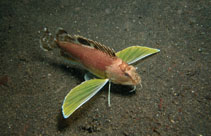| Family: |
Apistidae (Wasp scorpionfishes) |
| Max. size: |
20 cm TL (male/unsexed) |
| Environment: |
demersal; marine; depth range 14 - 60 m |
| Distribution: |
Indo-West Pacific: Red Sea and the Persian Gulf south to Natal, South Africa and east to India and the Philippines, north to China and Japan, south Australia. |
| Diagnosis: |
Dorsal spines (total): 14-16; Dorsal soft rays (total): 8-10; Anal spines: 3-4; Anal soft rays: 6-8. Bluish grey in color, belly pale; large black spot on rear half of spinous dorsal (Ref. 4313).
Description: Characterized by pinkish grey color; white or pinkish saddle across top of nape; posterior portion of spinous dorsal fin with ocellated black spot; soft dorsal and caudal fin with white spots; dusky yellowish grey on inner surface of pectoral fins; lowermost pectoral ray detached from fin; large and wing-like pectoral fins extending to about end of anal fin or nearly to caudal peduncle; two small spines in lacrimal directed downward; tip of chin with long slender tentacle and similar tentacles on middle of each lower jaw; depth of body 3.2 in SL (Ref. 90102). |
| Biology: |
Inhabits soft bottoms of the continental shelf. Primarily known from trawls over prawn-grounds but divers looking in suitable habitats can come across them, especially at night. During the day it buries itself deep in the sand with just the eyes exposed. When disturbed, it spreads its long pectoral fins with the bright upper color to deter predators. It uses its fins to corner prey and has sensitive barbels below the mouth to detect those buried in the substrate (Ref. 48635). Fin spines venomous (anterolateral glandular groove with venom gland (Ref. 57406)) (Ref. 30573). Sold in small quantities either fresh or dried and salted in markets. Minimum depth reported taken from Ref. 57178. |
| IUCN Red List Status: |
Least Concern (LC); Date assessed: 20 June 2017 Ref. (130435)
|
| Threat to humans: |
venomous |
Source and more info: www.fishbase.org. For personal, classroom, and other internal use only. Not for publication.
